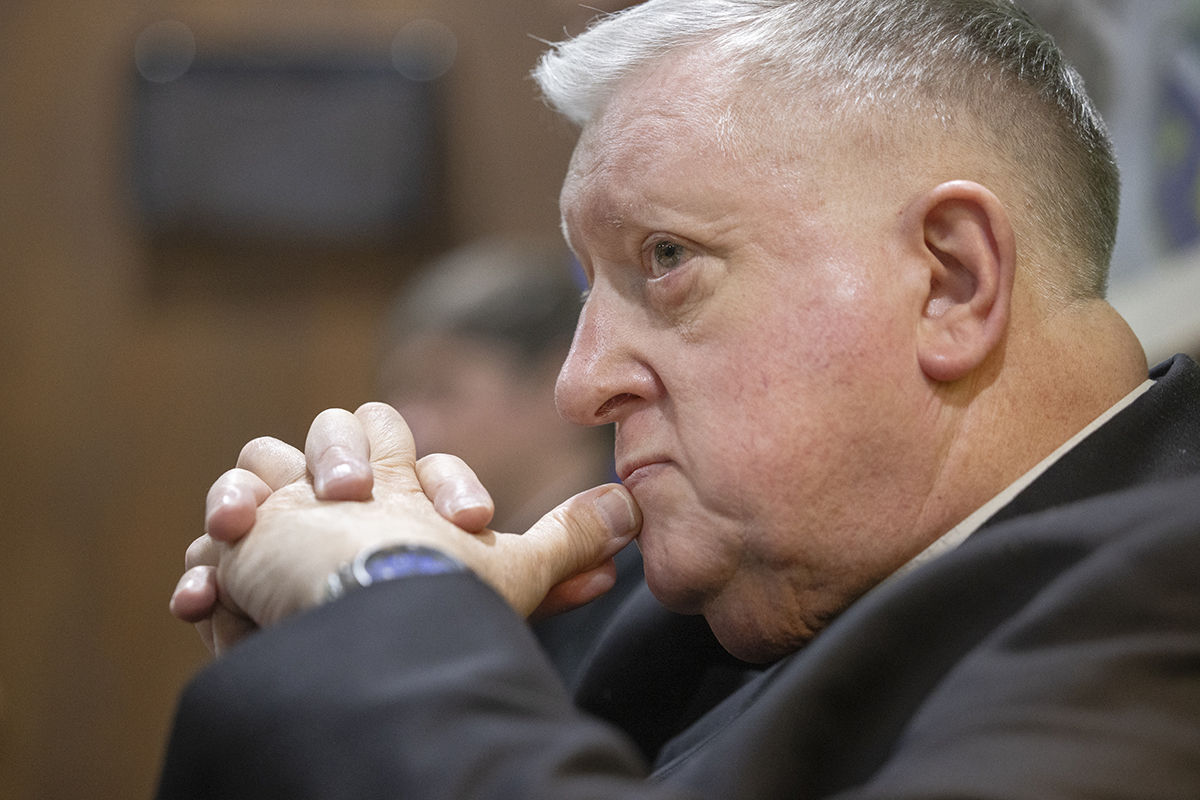Concert connects with parish’s military history
St. Bernadette Parish hosts Oakville High School band in its efforts to honor D-Day
The young band members held their instruments and stood at attention as a color guard from the Missouri National Guard marched onto the ballfield at St. Bernadette Parish in south St. Louis County.
In the background, underneath a blue sky, were thousands of white grave markers in neat rows among green grass.
St. Bernadette hosted a free concert, “Marching in the Footsteps of Valor,” on June 1 overlooking Jefferson Barracks. The performers were part of the Oakville High School Band, and the parish hosted the community concert to help kick off the band’s fundraising campaign. Oakville was invited to take part in the 75th anniversary commemoration of the D-Day landings next year in Normandy, France. There, band members will honor U.S. World War II veterans. The band received the invitation because of their participation at the President’s Cup in Washington, D.C., in 2017.
Volunteers from St. Bernadette spruced up the field and decorated the tables at the concession stand in a USA theme. A cooling station opened in the parish gym. People brought their folding chairs, rode a bus from a parking area at Sylvan Springs Park and sat in the shade.
Greg Meier, who along with his wife, Donna, are youth ministers at the parish, helped coordinate the event. He said St. Bernadette was an appropriate site because it looks over the military installation and national cemetery. Before expanding into the Lemay area, St. Bernadette Parish was established with the same boundaries as the former military post. Its church was the former barracks movie theater. Today, Jefferson Barracks is an active base for National Guard and Army Reserve units, and military personnel often attend Mass at the parish or use the gym.
“We welcome the opportunity to support the military and youth,” Meier said. “This is a great combination of the two.”
Jeannie Kohnen, a volunteer from St. Bernadette, said “it’s great to support the students. We have a perfect spot here. This combines Church and state, public school, the Catholic Church and the men in the military.”
Kohnen noted that emblems of the military branches are displayed in the vestibule of the church, and military statues grace the grounds of the parish.
Deacon Michael Buckley, sitting in a folding chair and taking in the concert, said “it’s a good outreach to the community.”
John Danner, a St. Bernadette parishioner, appreciated the effort and the parish’s appreciation of veterans. “I’m a big flag-waver. I like to see young kids honor the flag,” he said before pointing to the cemetery grounds and noting that he served on an honor guard for burials there.
Danner spent eight years in the U.S. Marine Corps in the Vietnam War years and pointed out that the reception “wasn’t like this when we came home.”
The band will have several performances on the trip. They are scheduled to play at the American Cemetery at Brittany, at Omaha Beach, and as part of the D-Day Memorial Parade in St. Mere Eglise. In addition, they plan to play at the Luxembourg Gardens in Paris.
Band members will learn about both French and American history.
The Meiers’ daughter, Christina, a senior at Oakville High School, said she is honored to join the nearly 150 students from her school to honor the veterans for their sacrifice. “I’m excited to share our music and our passion with people from around the world,” she said.
It means a lot to have the kickoff at her parish, Christina Meier said. “People from my church have been extremely supportive of me, and I’ve played my flute at Mass before. It was cool to share my church with my friends in band who may not realize I go there. It’s a place where I’ve grown up.”
Sophie Kettenbrink, a sophomore at Oakville High School and a Queen of All Saints parishioner who plays tenor saxaphone in the band, said that “a lot of my ancestors were in the military, Army and Navy, and it will be a nice way to remember them.”
D-Day
American, British, Canadian and other Allied troops landed on Normandy’s beaches on June 6, 1944, to begin the liberation of Europe from Nazi occupation.
The D-Day landings were the most vital part of the greater Operation Overlord to liberate Europe. Allied planning for a massive invasion of German-held France were underway as early as 1943. The Normandy coast west from the Orne River Estuary to the Cotentin Peninsula was chosen for its flat, firm beaches, and to take the German military off guard. German intelligence thought an Allied invasion would occur much closer to Britain, on France’s most northerly beaches.
Established in 1826, Jefferson Barracks is the oldest continually operated military post west of the Mississippi River and is a National Historic Site. The 135-acre site in St. Louis County is home to several military museums, Jefferson Barracks Nation Cemetery, and serves as an active base for National Guard and Army Reserve units.
Jefferson Barracks played a prominent role in every American conflict from the time of its founding until the Army declared it surplus in 1946. During the Civil War, the post housed one of the nation’s largest military hospitals, making critical advances in the treatment of wounded sent there from distant battlefields. Among the “firsts” occurring there are the barracks’ initial mission as the U.S. Army’s first basic training center, the organization of the First Dragoons (forerunners of the American cavalry), the first successful parachute jump from an airplane, and the operation of the first Army Air Corps Technical Training School.
The barracks provided the first military escort to merchant trains on the Santa Fe Trail, sent exploratory and protective troops out on the Oregon Trail, and served as a central depot sending both men and supplies to a major network of western forts active during the various Indian Wars. Its purchases of foodstuffs and manufactured goods and the need for means of transport to other posts played a substantial role in the commercial growth of St. Louis as a mercantile, manufacturing and distribution center.
Hundreds of Civil War generals on both sides of the conflict served there, including Ulysses S. Grant and Robert E. Lee.
Although the United States did not officially enter World War II until the attack on Pearl Harbor in late 1941, preparations for mobilization that began in the late 1930s once again changed the primary function of Jefferson Barracks. It changed from a training site to an induction and reception center for the eastern half of Missouri.
St. Bernadette Parish acquired a building in 1950 that is used as its rectory. It was used as an induction center and for dental offices. The post theater has been St. Bernadette Church since 1952.
Source: Jefferson Barracks






